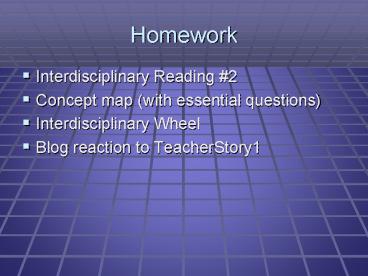Homework PowerPoint PPT Presentation
1 / 16
Title: Homework
1
Homework
- Interdisciplinary Reading 2
- Concept map (with essential questions)
- Interdisciplinary Wheel
- Blog reaction to TeacherStory1
2
- Interdisciplinary Curriculum Design
3
What is Interdisciplinary curriculum?
A way to organize the curriculum, so that
the content of one subject area is enriched
and reinforced by another, and vice versa.
4
Language Arts
Mathematics
THEME
ELD
Music
Science
Social Studies
An integrated thematic unit
5
Theoretical and Historical Background
John Dewey (1913) . . . Education comes only
through willing attention to and participation
in school activities. It follows that the
teacher select these activities with reference
to the childs interests, powers, and
capacities.
James Mursell (1956) Integration has to do,
not primarily with subject matter, but with
people and their lives.
Lev S. Vygotsky (1962) Each person must
construct his or her own reality . . .
construction should always precede analysis.
6
Benefits
- improves higher order thinking skills
- gives the learner a more unified sense of process
and content - improves the learners mastery of content
- teaches the student to adopt multiple points of
view on issues - gives them ownership of their own studies
- improves their motivation to learn
-Ellis and Fouts (2001)
7
Connections ApproachWiggins and Wiggins, 2001
- Thematic or content connection
- Conceptual connections
- Process connections
8
Thematic or content connections
Language Arts Read and respond to Biography
of Eleanor Roosevelt
Mathematics Graph various government Positions
held by women
THEME Women whove a difference
ELD Interview women in the Community about
their Accomplishments goals.
Music Listen to/analyze music by women composers
Science Accomplishments of Women scientists
Social Studies History of womens suffrage
9
Conceptual or Process connections
Common to various disciplines
Knowing how a process functions in one
discipline can enhance the students
understanding of how it functions in another.
(Wiggins, 2001)
Verbal literacy Listening Speaking Reading
Writing
Musical understanding Performing Creating
Listening
(Deriving meaning more than mere decoding)
(A deep understanding More than mere
note-reading)
10
Process connections (continued)
Other discipline
Music
- (Science/Kinder) Compare and sort common objects
by one physical attribute. - (Science/Gr. 4) Differentiate among types of
rocks by referring to their methods of formation. - (Math/Gr. 1) Describe, extend and explain ways to
get to a next element in simple repeating
patterns. - (Language Arts/Gr. 4) Compare and contrast tales
from different cultures by tracing the exploits
of one character type.
- Compare and sort common instruments by one
physical or aural attribute. - Differentiate between musical textures by
referring to their methods of formation (e.g.,
fugues, homophonic forms) - Create, perform and describe simple rhythmic and
melodic patterns. - Compare and contrast music from different
cultures by tracing the musical treatment of one
instrument type.
11
True IntegrationGuidelines
- Have clear instructional goals, based on the
state standards, for your students. - Maintain the integrity of each discipline.
- Provide opportunities for the students to clearly
see the cross-disciplinary connections. - The connections must be concept or process
oriented. - Always consider Bloom!
12
Start with Essential Questions
- Have no obvious right answer
- Raise other important questions
- Address the philosophical or conceptual
foundations of a discipline - Recur naturally
- Are framed to provide and sustain student
interest! - Write an Essential Question for each CONTENT
area that connects to the others
13
So lets see some examples
http//edweb.sdsu.edu/courses/edtec596/Units/UnitI
ndex.html
- Decide
- Are the units Interdisciplinary (or thematic)?
- Do they offer authentic connections?
- What are the big ideas the writers are
attempting to address? - What are the essential questions?
14
Can We talk?
- In a small group, answers these questions
- Are the units Interdisciplinary (or thematic)?
- Do they offer authentic connections?
- What are the big ideas the writers are
attempting to address? - What are the essential questions?
- At the end of the time, regroup and write a
ONE-DAY interdisciplinary unit on
15
(No Transcript)
16
So lets see look at YOUR final product!
- Final Product
- Final Product Rubric
- Concept Web
- Interdisciplinary Wheel
- http//clem.mscd.edu/cstocke1/templates.htm

